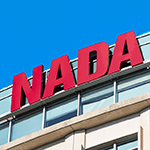NADA Issues Analysis of 2022 Auto Sales and 2023 Sales Forecast
TYSONS, Va. (Jan. 11, 2023)—The National Automobile Dealers Association (NADA) issued its analysis of 2022 U.S. auto sales and the economy.
“Simply put, there were more buyers than there were cars in 2022,” said NADA chief economist Patrick Manzi. “With razor thin inventory levels, vehicle sales took a bit of a hit in 2022.”
2022 ended with new light-vehicle sales reaching 13.7 million units, the lowest full year sales total since 2011. Year-over-year 2022 sales decreased 8.2% compared to 2021 with the decrease primarily attributed to the ongoing semiconductor microchip shortage and additional supply chain disruptions.
In 2022, light-trucks accounted for nearly 80%, 79.4%, of all new vehicles sold, up 1.6% from 2021. Crossovers remained the most popular segment representing 45.2% of all new light-vehicles sold. Alternative fuel vehicles also gained market share with sales of hybrids, plug-in hybrids (PHEVs) and battery electric vehicles (BEVs) accounting for 12.3% of all new vehicles sold, an increase of 2.7% compared to 2021.
Franchised dealerships nearly doubled the number of BEVs they sold in 2022, reaching 259,728 in 2022, an increase of 92.1% compared to 2021. Franchised new-car dealerships captured 35.2% of the total new vehicle BEV market with continued BEV sales growth in 2023 as new models from legacy automakers hit showrooms and more BEV inventory is available.
When contrasting vehicle sales to inventory, inventory levels at the end of December 2022 totaled 1.67 million units, a 49% increase compared to the total 1.12-million-unit inventory at the end of 2021. According to Wards Intelligence, North American light-vehicle production is expected to total 14.2 million units in 2022 with production forecasted to rise to 15.4 million units in 2023 as supply chain issues improve gradually.
On the cost side, the average new vehicle price in December 2022 is expected to be $46,382, an increase of 2.5% compared to December 2021. Incentive spending in 2022 also remained depressed with average incentive spending per unit expected to total $1,187 per unit in December 2022, a decline of 21.4% year-over-year, according to J.D. Power. Despite overall lower incentive levels, December 2022’s incentive total marks the second month that average incentive spending per unit topped $1,000, following six consecutive months below $1,000 per unit.
Higher vehicle prices, depressed OEM incentive spending and surging interest rates pushed monthly consumer car payments higher as the year progressed. According to J.D. Power, in December 2022 the average monthly payment for a new vehicle finance contract is expected to be $718 and the average interest rate on those contracts should total 6.4%, increases of $47 and 247 basis points year-over-year respectively.
These factors, coupled with OEM production decisions that skewed to higher trim, more expensive models, will put further pressure on vehicle affordability. However, as inventory builds, a cooling of price increases coupled with higher incentives is anticipated.
In 2023, NADA anticipates new-vehicle sales of 14.6 million units – an increase of 6.6% from 2022.
At the macro level, inflation has begun to cool across the economy with the Bureau of Labor and Statics’ Consumer Price Index (CPI) declining from its peak of 9% year-over-year in June 2022. According to the CPI prices were up 7.1% year-over-year at the end of November 2022. Core CPI, which excludes volatile food and energy prices, has fallen to 6% year-over-year in November 2022, down from its peak of 6.7% in September 2022. NADA expects increases of the CPI should fall to 4% to 5% year-over-year by the end of 2023.
As the inflation situation has improved so has consumer sentiment, which has ticked up since reaching its lowest point during the summer months when inflation was at its highest point. Despite this improvement, consumer sentiment remains very low when compared to pre-pandemic levels and the post-vaccine peak level in April 2021.
In the third quarter of 2022, the country’s labor market fully recovered the total number of jobs lost during the pandemic. And the labor market continued to improve during the 4th quarter as well as employers added 742 thousand jobs in Q4 2022 and the unemployment rate fell to 3.5% as of the end of December 2022. As prices across the economy have increased, so have average hourly earnings.
Throughout most of 2022, average hourly earnings have steadily increased roughly by 5%. At franchised dealerships, average annual earnings were up by roughly 4% year-over-year as of the end of Q2 2022 according to U.S. Bureau of Labor Statistics’ Quarterly Census of Employment and Wages. Despite solid wage gains, increasing prices across the economy have outpaced wage gains leading to real wage decline for the average worker.
At franchised new-car dealerships, employment totaled 1.07 million at the end of November 2022, virtually unchanged from prior months; throughout 2022, employment at franchised dealerships has hovered at approximately 3% to 4% below pre-COVID levels.
In 2022, the Federal Reserve increased interest rates seven times, with the final increase in December 2022, the targeted range on the Federal Funds rate was 4.25% to 4.5% at the end of the year. The Fed’s moves pushed new and used vehicle borrowing costs above their pre-pandemic levels. Auto lending rates are expected to climb even higher in the first half of 2023 as Federal Reserve interest rate increases are likely to continue.
“Despite pressures on the economy and consumers’ wallets, new-vehicle demand remains elevated,” said Manzi. “With the worst of the chip shortage behind us and new vehicle production set to increase, new vehicle sales are expected to improve in 2023 after declining last year.”
Click here to read the full December 2022 NADA Market Beat report.
Media Contacts

